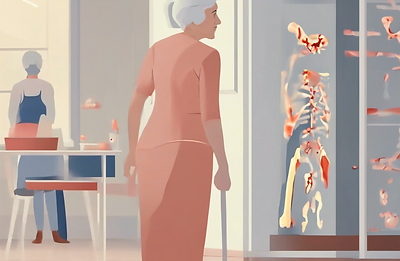It’s More Than “Just a Pinch”
Lisa Samy
January 2024
Hysteria. It’s a word that has stigmatized women throughout the ebb and flow of history, bunching a plethora of illnesses—and all women—into one category.[1] While this term lost its place as an official diagnosis, its connotation still negatively affects modern medical care. A recent study shows that doctors tend to undermine women’s pain compared to men and that women should primarily seek psychotherapy to alleviate their pain.[3] This originates from the subconscious, stereotypical belief that women are more “openly expressive” and “more emotional” when tolerating pain.[3] Therefore, there’s no need to take extra precautions, even for an extremely invasive procedure that myriad women dread having to endure: gynecological
exams.
Pain Isn’t Static
Lauren Capps, 28, accounts her past pap smears—a procedure where a medical provider scraps cells from a patient’s cervix to test them for cervical cancer—with, “I just remember the most terrible pain,” and, “I remember feeling violated.”[2] Additionally, Cooper Owens, 43, underwent a cervix dilation without anesthesia—she recalls, “I have never gone through that kind of physical agony in my 43 years of life.”[2] In the end, these women are shrugged off by medical providers because, well, childbirth hurts. Periods hurt. Women go through them all the time.
Therefore, women’s pain is routine.
The bottom line is this: levels of pain tolerance aren’t universal from person to person. When the line between necessary discomfort and pain blurs, so too does a medical provider’s judgment. That’s when it feels easy for a medical provider to laugh off a woman’s pain, or continue with the exam even though the patient doesn’t feel comfortable doing so.

For women who have experienced sexual assault, the barriers are even higher. Huma Farid, a practicing gynecologist and instructor at Harvard Medical School, says her patients who “experienced sexual assault confess that they have avoided or delayed seeking medical care due to their anxiety surrounding pelvic exams.”[4] Furthermore, these women have higher rates of post-traumatic stress disorder (PTSD), which instills the fear that they may relive their trauma during the exam.[4] This, of course, puts fearful and traumatized women at a higher risk of suffering from undiagnosed illnesses like cervical cancer or endometriosis.[1]
What Can Medical Providers Do?
Most medical providers wouldn’t intentionally harm their patients; however, biases, inattentiveness to a patient’s comfort, and a lack of pain management may cause them to inflict physical and/or psychological pain on their patients. The key to mitigating these issues is to reevaluate their mindsets toward women’s care; in particular, they can focus on a particular goal: individualized patient care.[2]
This entails caring for a patient’s unique needs, fears, and ultimately, adjusting standardized procedures to their comfort. Medical providers can offer pain medication such as topical numbing cream before the procedure starts. Furthermore, they should remind the patient that they have full control and bodily autonomy, and encourage the patient to control the pace of the procedure. If the patient feels overwhelmed or is in excruciating pain, the medical professional must stop and ascertain their condition. If they’ve exhausted all their other options to continue the procedure, then there is only one option: schedule the appointment another time and prepare accordingly. Rescheduling should preferably be cost free to ensure the patient does not incur additional stress over finances and affordability. This in turn, helps the patient feel genuinely cared for and supported by their medical provider.
What Does Good Care Look Like?
For Kendra Perry, 47, her experience with an ideal medical provider is a paragon of good patient care. After several unsuccessful, and painful, attempts of undergoing an endometrial biopsy, even with prescribed medication, her medical provider opts to reschedule her appointment to conduct the procedure under general anesthesia for a pain-free experience.[2] Perry, pleased and relieved, says her gynecologist, “respected what [her] body could and couldn’t tolerate, or could and couldn’t do.”[2] To many people, this sounds like a pipe dream. And it’s about time this shifts into a shared reality for all women.
References
[1] Brooks, Laken. (2021). Painful Gynecological Visits Can Be Traumatic Instead of Healing. Forbes.
https://www.forbes.com/sites/lakenbrooks/2021/11/06/painful-gynecologist-visits-can-be-trauma tic-instead-of-healing/?sh=ffe63e847dbb
[2] Nudson, Rae. (2022). Gynecology Has a Pain Problem Our discomfort is routine. What if it didn’t have to be? The Cut. https://www.thecut.com/2022/06/pain-in-gynecology-practice-exams.html
[3] Zhang, Lanlan. (2021). Gender Biases in Estimation of Other’s Pain. The Journal of Pain. https://www.jpain.org/article/S1526-5900(21)00035-3/fulltext
[4] Farid, Huma. (2019). When a pelvic exam is traumatic. Harvard Health Publishing. https://www.health.harvard.edu/blog/when-a-pelvic-exam-is-traumatic-201901291586


